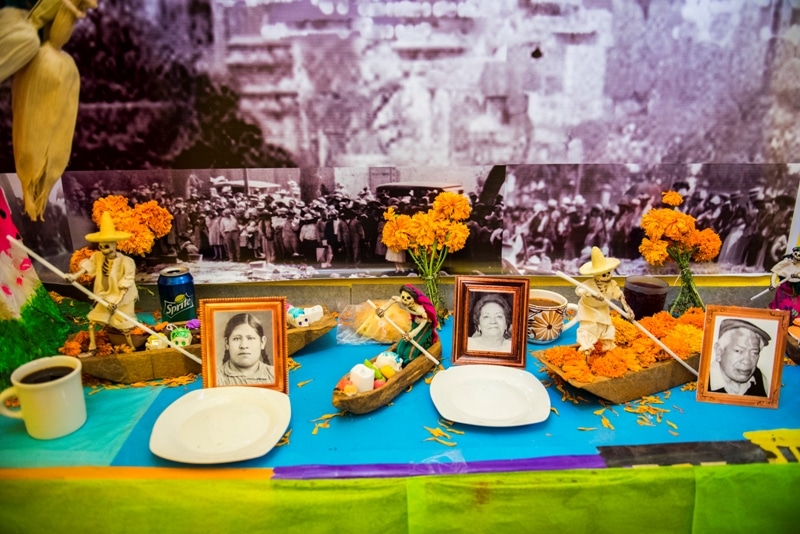What it’s like to celebrate Day of the Dead in Mexico City

During the four years I spent en el DF, Day of the Dead always reminded me of Thanksgiving — a time to be with family, reflect on what you’re grateful for, and eat loads of delicious food. But what I loved even more about Day of the Dead was its direct connection to nature and the senses, and to history and lineage. I loved that Day of the Dead always forced me to stop what I was doing and remember the people who came before me.
First, every year, there are the marigolds, or cempasúchil. This flower, intricately tied to Day of the Dead, appears around the city toward the middle of October, on Reforma Avenue and in markets and businesses. Day of the Dead altars pop up at my favorite taquerías and restaurants, decorated with marigolds, candles, sugar skulls, and funny little oficios, or mini-skeletons performing various daily tasks like sitting at an office desk, slicing al pastor meat, working out at the gym, or baking bread.
Squat, plump pumpkins fill up the markets, along with tejocotes, or Mexican Hawthorn apples, whose creamy flesh tastes like a cross between an apple and a pear. Vendors hawk Day of the Dead artesanías, or arts and crafts: cut tissue paper called papel picado and delicate, colorful small animals, such as sheep and hens, crafted entirely from sugar.
Where to Visit: Jamaica Market
At Mexico City’s Jamaica Market, a 24-hour market known for its wholesale flowers, Day of the Dead culture truly shines. Truck beds overflow with marigolds, known as cempasúchil in Spanish, and a red velvety flower called terciopelo. Vendors sell sugary cups of calabaza en tacha, a candied pumpkin flavored with molasses-y piloncillo syrup, cinnamon, guava and spices. And there is pan de muerto, which roughly translates to “bread of the dead,” comprising round, sugar-dusted rolls striped with ropy “bones.” The bread, sometimes dusted with sesame seeds instead of sugar, is usually flavored lightly with orange-blossom water. Stand after stand sells everything you’d need to make an altar at home, and the products are eye-catching even if you’re not making an altar.
My Own Day of the Dead Celebration
I am Mexican-American, but I’d never really celebrated Day of the Dead until I moved to Mexico. After just one October in Mexico City, I found myself buying all the seasonal items at the markets and trying to learn what to do. It’s customary to put up photos on one’s altar of family members who’ve died, so I asked my parents for photos of my grandparents. I unearthed a photo of my stepfather who died unexpectedly when I was 17. We found photos of my husband’s great-grandparents and framed those for our altar, along with the other pictures.
Most people also put out food, or little sugary replicas of foods, that their loved ones liked to eat. My grandmother used to make me flour tortillas oozing Monterey Jack cheese whenever I visited her, so I bought a tiny sugar-sculpted plate of quesadillas at a local market. Mexico City markets sell dozens of these dishes like these–tiny, sugar-spun plates of mole, enchiladas, pan dulce, gorditas–only at Day of the Dead, just for that purpose.
A class on Day of the Dead traditions at the Escuela de Gastronomía Mexicana in Roma taught me the rest of what I’d need for my altar: flowers, candles, fruit to symbolize nature’s abundance, papel picado to symbolize wind, a glass of water for thirsty loved ones who’ve departed this world, and a little ceramic sculpture of a Mexican hairless dog, the Xoloitzcuintle, to accompany my loved ones into the next world.
Every year that I celebrated Day of the Dead in Mexico, I didn’t want to take my altar down. With more than a little sadness that the holiday was over, I’d carefully wrap all of my artesanías in tissue paper and store the items in a plastic bin. They’ve since traveled with me across two more moves in the United States.
A few of my sugary animals and oficios have broken, but I have more photos of departed loved ones now. I’m eager for my 2-year-old son to see this year’s altar and ask questions about the family members he never knew.
Eat Mexico offers a Day of the Dead Tour of Mexico City’s Jamaica Market every October. Click here to book.
Lesley Téllez is the author of Eat Mexico: Recipes from Mexico City’s Streets, Markets and Fondas. She is the owner/operator of Eat Mexico Culinary Tours.